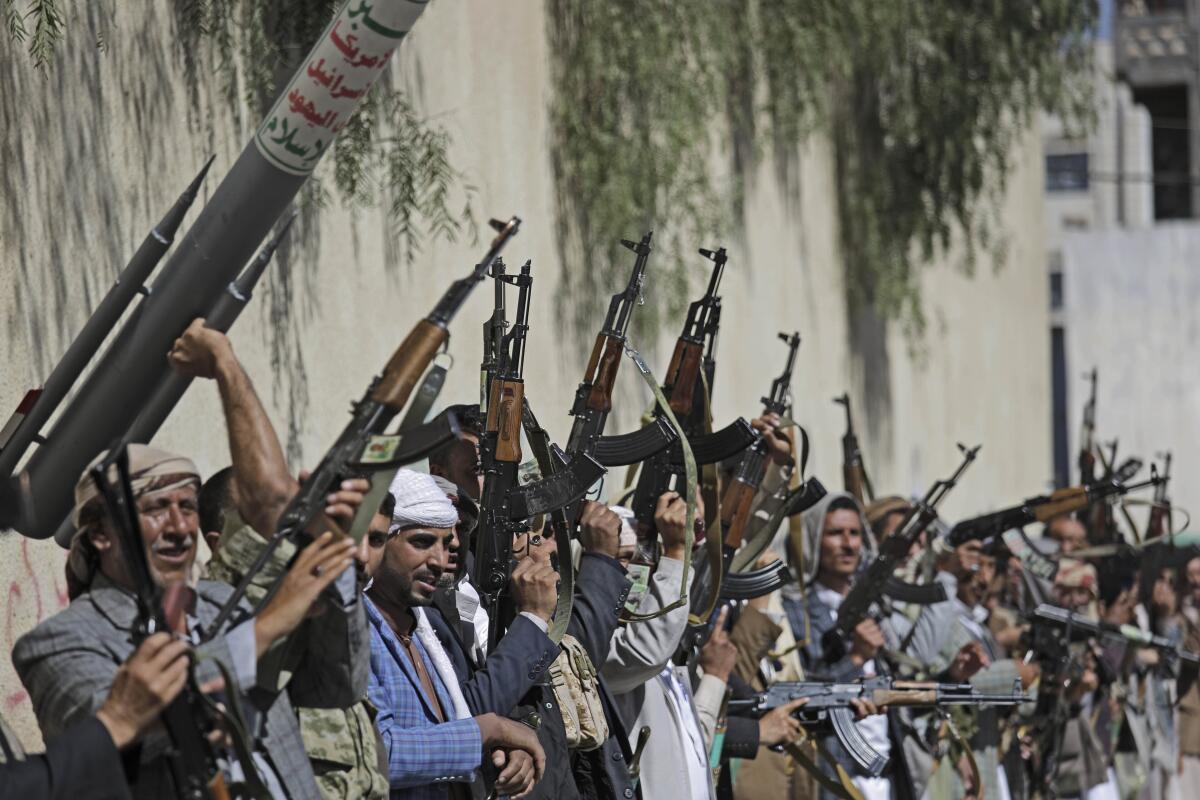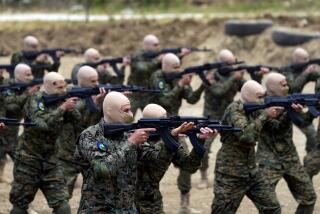Attempts for Middle East cease-fires amid the coronavirus crisis have not stopped the fighting

BEIRUT — With governments worldwide increasing health measures to keep the spread of the deadly coronavirus at bay, one might think there would be virtually no time for waging war.
But it hasn’t turned out that way, at least not in parts of the Middle East.
Despite calls for a global cease-fire — “It’s time to put armed conflict on lockdown,” said U.N. Secretary-General Antonio Guterres in a statement in March — regional conflicts appear to be immune to the coronavirus even as more than 4,000 have died across the Middle East and almost 90,000 people have confirmed cases.
In Syria, Iraq and Yemen, as authorities have shut down businesses and imposed curfews, battles between the belligerents have persisted.
In Libya, they’ve intensified.
For almost a year, the Libyan capital, Tripoli, and the country’s U.N.-backed government led by Prime Minister Fayez Serraj has been the target of a wide-scale campaign by Gen. Khalifa Haftar, a renegade general who aspires to consolidate his rule across the country. Since last April, more than 2,000 people have been killed, humanitarian groups estimate, including 300 civilians; some 150,000 have been internally displaced.
After the ouster of Libyan strongman Moammar Kadafi in 2011, the country has been wracked by successive waves of civil war. After intense diplomatic efforts by the U.N., Serraj and Haftar participated in talks in 2019 to forge a new unity government. As they were on the cusp of an agreement, Haftar launched an onslaught of drones, artillery and Russian mercenaries on Tripoli.
The latest combat, said Amru Salahuddien, a photographer embedded with forces loyal to the Tripoli government, has also been intense.
“Haftar is taking advantage of the world being preoccupied to escalate,” Salahuddien said in a phone interview Wednesday from Tripoli.
Over the last few weeks, U.N. officials, world leaders and humanitarian groups launched multiple appeals to suspend hostilities so that basic medical equipment and protective materials could be distributed, said Caroline Gluck, spokeswoman for the U.N.’s refugee agency in Libya. As of Friday, the country had 11 confirmed cases of the novel coronavirus and one death.
“It’s really disappointing. It has gotten worse in the last week to 10 days, which is really concerning,” she said. “The people who are suffering are civilians, and people are very fearful, they’re scared.”
There’s a 12-hour curfew after 6 p.m., with various areas under lockdown and travel between cities forbidden. Jobs are harder to find while Haftar’s forces have imposed an oil blockade, sending fuel prices skyrocketing. Social distancing is something most cannot afford: Refugees cram into rooms shared by anywhere from six to 10 people in Tripoli and elsewhere.
At particular risk are the more than 600,000 migrants trying to leave Libya’s shores for Europe. They face increasingly harsh conditions, Gluck said, with landlords throwing them out of rental properties or taxis refusing them service as fears of the virus blend with xenophobia.
In a nod to the requirements of the outbreak, militiamen defending Tripoli dutifully donned surgical masks and headed to the front, Salahuddien said.
“But they only put them on the first day they got them because they were excited to try something new. I haven’t seen anyone putting a mask on again since,” he said. “If the virus gets to these groups, it’ll spread like wildfire.”
In Syria, the government of President Bashar Assad had reported 10 confirmed cases of coronavirus, including two deaths.
But the Assad government is dealing with a country fractured by nine years of conflict, and testing capabilities are low. Many observers fear the number of those infected is far higher.
“Judging from other places, that is the tip of the iceberg,” Mark Lowcock, head of the U.N.’s Office for the Coordination of Humanitarian Affairs (UNOCHA), said of the Assad government numbers during a briefing to the Security Council this week.
Syria’s health services are extremely fragile, he said, with approximately half of its hospitals and primary healthcare centers destroyed in the nine-year conflict.
The country has some 6.1 million internally displaced people — almost a million of them in the opposition-controlled province of Idlib — living in tents or the carcasses of buildings.
The government has taken a series of increasingly restrictive measures, including curfews that start at noon and end at 6 a.m. the next day, shutting down all but the most essential businesses and suspending travel as well as public transport.
Yet the restrictions have not stopped the fighting. On Wednesday, government forces and rebel factions accused each other of breaking an ever-tenuous cease-fire in northwestern Syria with renewed bouts of artillery and mortar shelling. There were no reports of casualties.
On Tuesday evening, Syrian state media and activists accused Israel of carrying out an airstrike on what a pro-opposition watchdog group said was an Iranian-controlled base in central Syria. Israel did not confirm such an attack.
The region has experienced a shadow war pursued by the U.S. and its allies to cut down Iranian influence. Both sides have engaged in tit-for-tat attacks, often conducted without claims of responsibility or by proxy forces.
Even without the coronavirus outbreak, Yemen has faced a humanitarian crisis. The country has gone through years of war, with a coalition led by Saudi Arabia seeking to dislodge the Iran-supported Houthi rebels from the capital, Sana. It has left the country in tatters and put it on the verge of famine.
Yemen, a country of some 24.5 million people which has so far reported no coronavirus cases, is under the control of rival governments. Both sides had given positive responses to calls for a cease-fire, according to a statement last week by the U.N.’s special envoy to the country, Martin Griffiths, so as to “fight the common enemy, COVID-19.”
Instead, the Houthis lobbed ballistic missiles over the weekend on the Saudi capital, Riyadh, and areas near the Saudi-Yemeni border, while their forces retook a military base in central Yemen. By Monday, Saudi warplanes were roaming the skies of Sana for the first time in months. They conducted 19 air raids, pro-Houthi media said.
The violence in Iraq continues as well, despite repeated warnings from officials and aid groups that the contagion could easily overwhelm the country’s shattered health system; authorities say it has 772 confirmed cases and 54 dead.
The U.S. last week accused Iranian-aligned paramilitary factions of conducting another in a series of rocket barrages targeting personnel with the U.S.-led coalition against Islamic State. The attack targeted an area near the U.S. Embassy in Baghdad and left no casualties. An earlier fusillade in March killed killed two Americans and a British soldier.
In recent days, the coalition has withdrawn from several outposts and consolidated its presence in a few major bases in western and northern Iraq as well as Baghdad. Coalition representatives have denied the moves were in response to the recent attacks, but said they were instead because Iraqi forces were increasingly more independent in conducting anti-Islamic State operations.
Islamic State, meanwhile, in March wrote in its weekly newsletter that the coronavirus was punishment upon the United States and its allies for their battle against the militant group.
“The duty upon the Muslims today, along with protecting themselves and their families from the disease,” the newsletter said, “is to increase the pressure on the infidels.”
More to Read
Sign up for Essential California
The most important California stories and recommendations in your inbox every morning.
You may occasionally receive promotional content from the Los Angeles Times.











